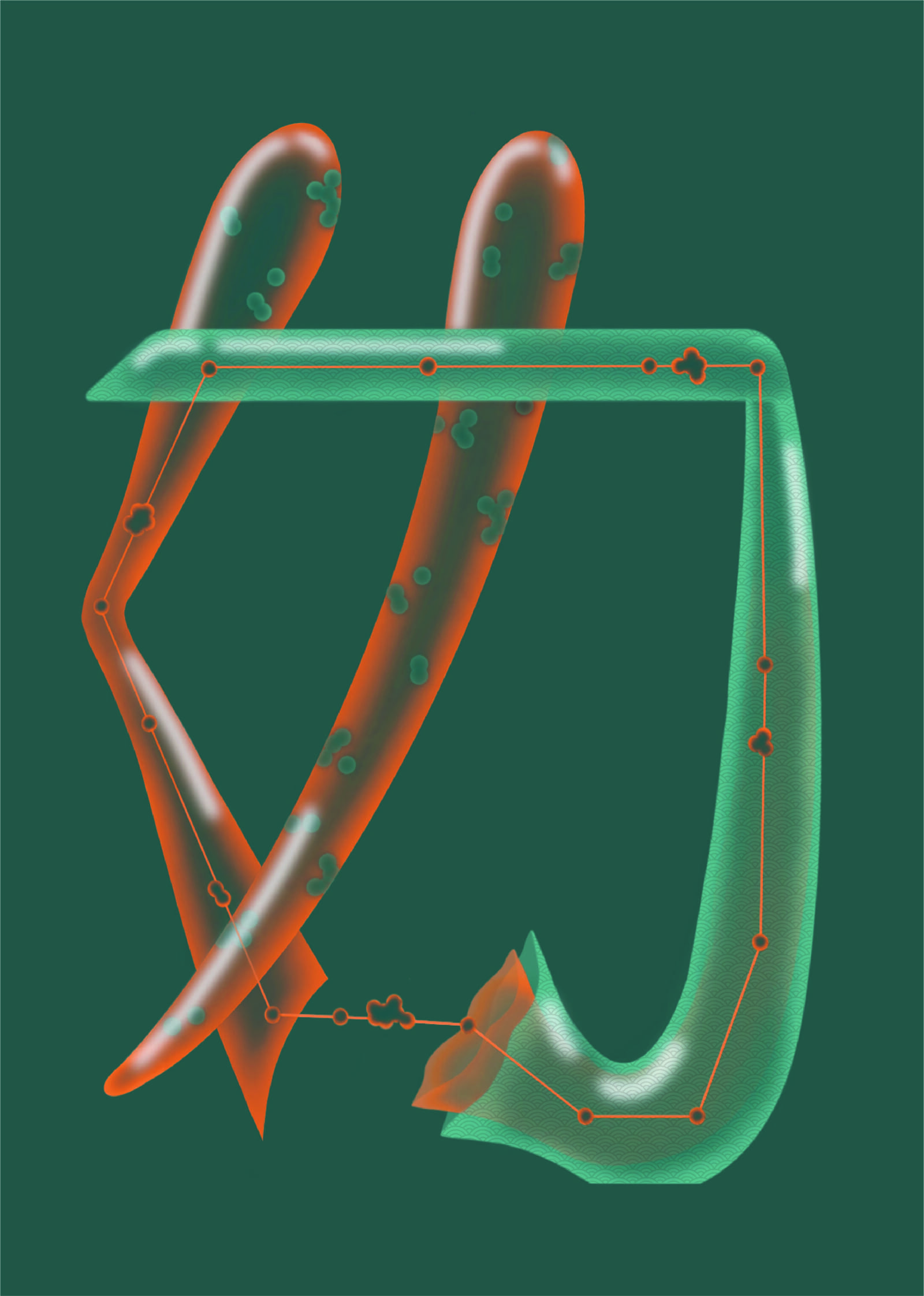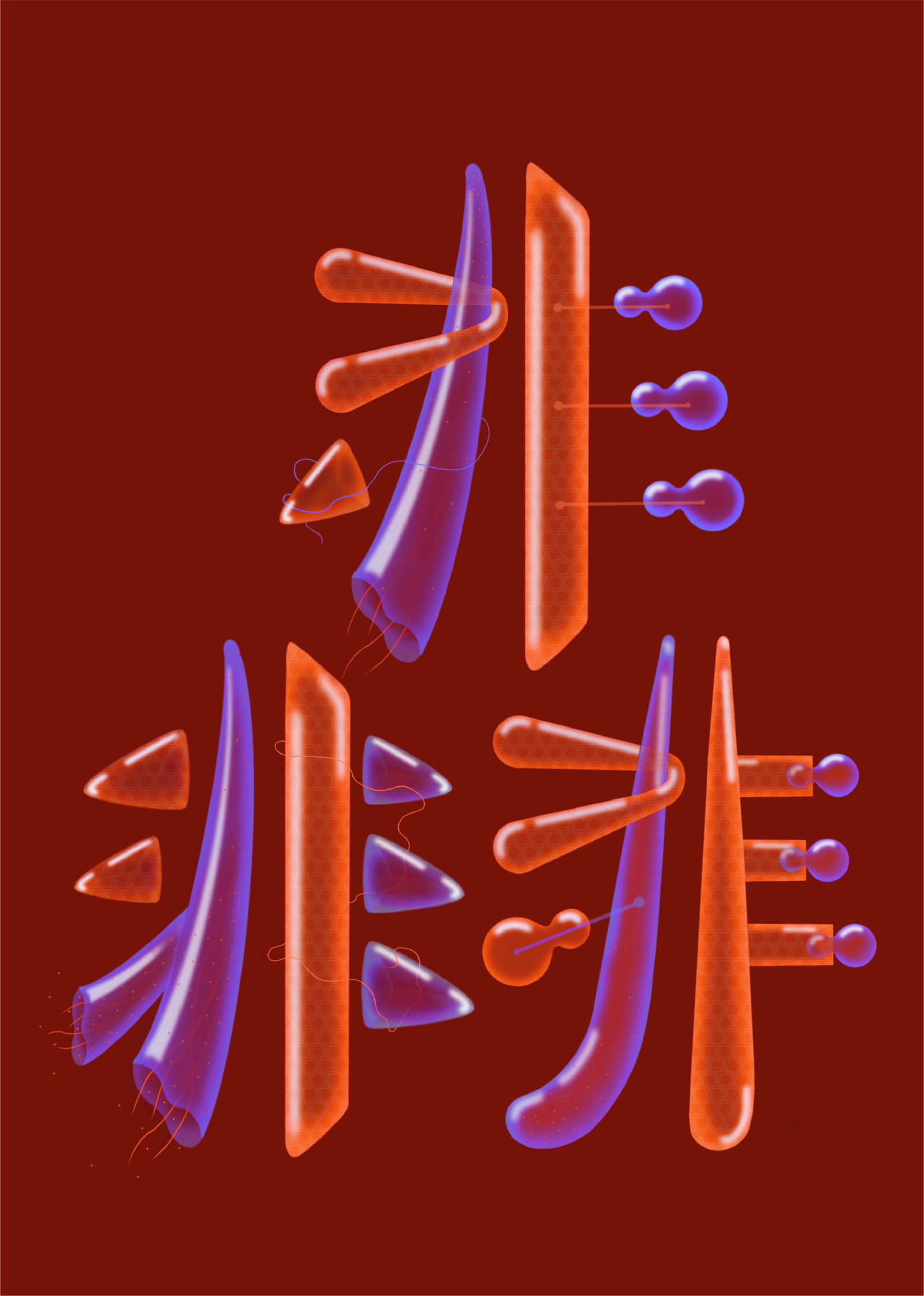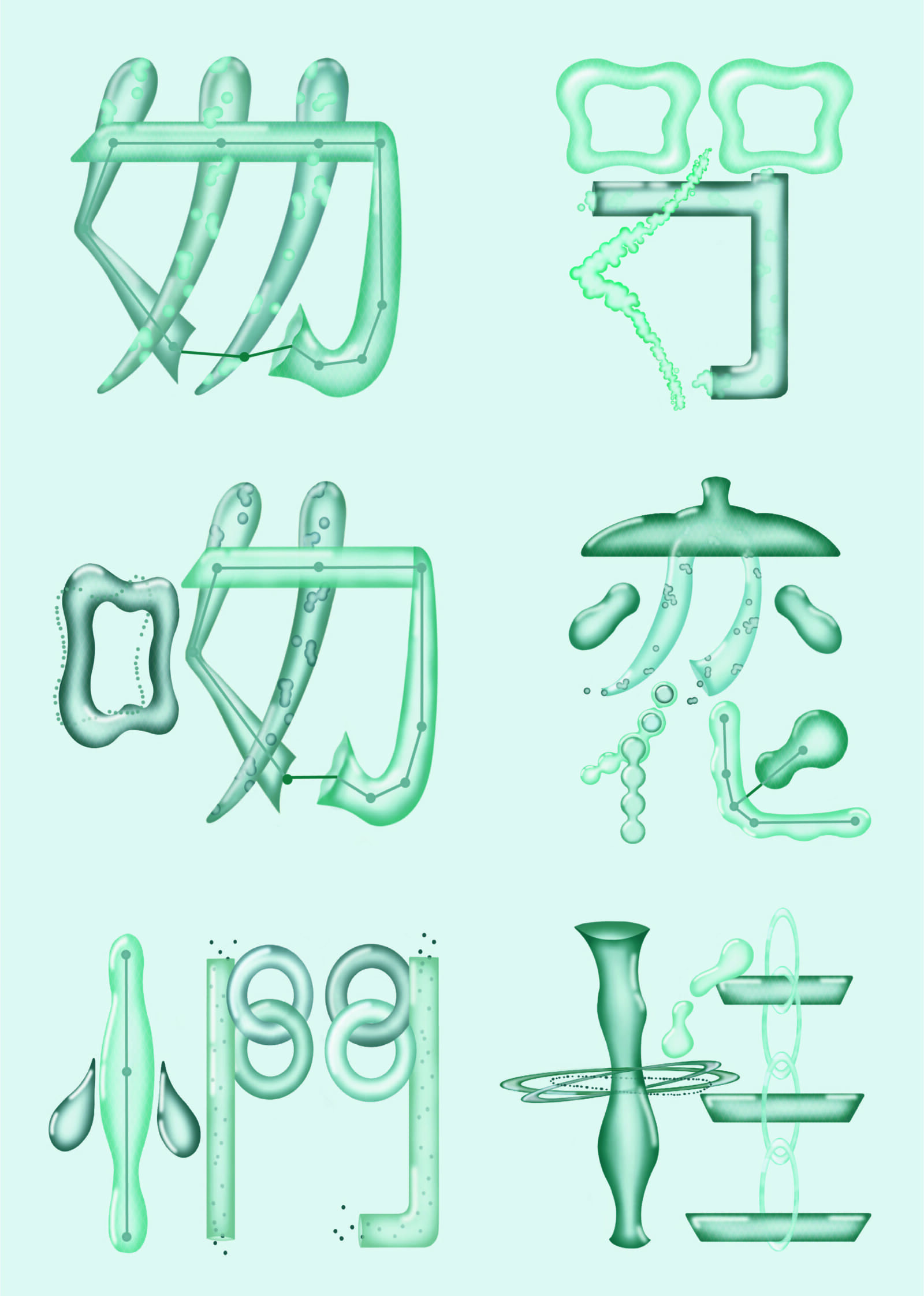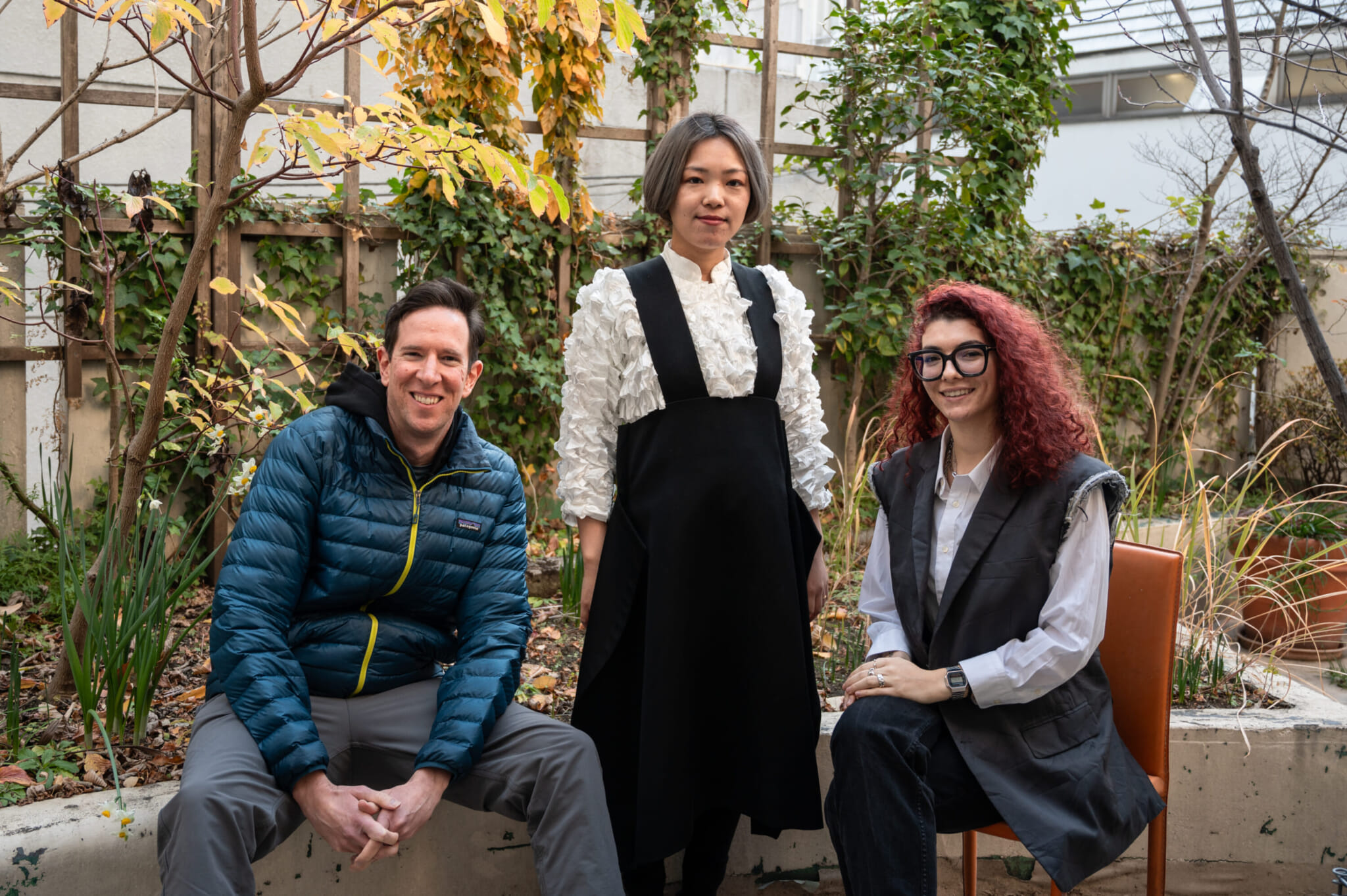“Living Kanji: Modernizing Script for a Changing Japan” is a graphic poster exhibition, running for four days from January 11 at Reload Shimokitazawa. It delves into the concept of societal evolution and questions why kanji, as a part of our evolving society, cannot undergo its own evolution. The creative triumvirate have reimagined traditional Japanese script by introducing modern logographic kanji that challenges the long-standing narratives, gender biases and LGBTQ+ exclusion that currently exist within the written language.
We had the pleasure of sitting down with the “Living Kanji” members — Japanese art director Hami Miharu Matsunaga, American copywriter Adam Gothelf and visiting Swiss graphic designer Chiara Mendolia, to learn more about the ideas and intentions behind their artwork.
The Concept Behind Living Kanji
According to the “Living Kanji” manifesto, the project is a “dynamic evolution of kanji characters, transforming their shapes and meanings to counteract gender biases in traditional kanji.” The concept considers kanji as “living entities, ready for change.” It all began as a thought experiment when these international creatives brought their ideas and experiences together.
“The way we use language shapes life itself,” says Gothelf. Kanji, the writing system originally from China and adopted for widespread use in Japan in the 5th century, has existed for thousands of years. “After a period of rapid evolution, certain kanji still in widespread use have stagnated and have not changed again for many years… they are trapped in poetic amber,” he explains. “If kanji could become alive again, what sorts of shapes and forms would they take?”

Living Kanji Poster
Having spent most of her life in Japan, it was a transformative experience for Matsunaga to spend nearly a year in Stockholm, Sweden in 2019, where she collaborated with creatives from all over the world. She felt that she looked back at her home country’s conservative society with new eyes. In conversation with Gothelf, she questioned “the invisible power of kanji to push women down.”
Japan still lags behind in gender equality, being ranked 125th overall and 138th in the political sphere out of 146 countries in the 2023 Global Gender Gap Index published by the World Economic Forum. “We aim to open discussions and envision what a more diverse and accepting society in Japan could look like, as envisioned by its people,” says Matsunaga.
For Mendolia, who was eager to take her communications and design studies from Lausanne, Switzerland, to Japan, “Living Kanji” is not only a culmination of her five-month internship, but an opportunity for her as a graphic designer to delve deeper into Japanese culture and to offer creative ideas for a more inclusive society. “Our project not only aims to integrate LGBTQ+ identities into Japanese culture but also to create the first-ever LGBTQ+ specific kanji,” she says.

New Living Kanji for “evil”
The Creation of New Characters
The creative process began by researching various kanji and their compounds. “We needed to understand the structure of kanji, its meaning and history,” explains Matsunaga.
The trio walk us through some examples, including “女” for “woman,” which in its current form, represents a kneeling or bowing woman, in contrast to “男” for “man” which combines the compound kanji “田” for “field” and “力” for “strength.” Surprisingly, there is further gender bias embedded in a number of other kanji, including “姦” for “evil,” “wicked” or “adulterous” which is created by merging three of the characters for “woman.” Matsunaga tells us that, “just through this kanji, we start to realize how society pushes women down.”
When it comes to reconstructing the narrative, she states that it is “important we think about the new idea behind each kanji. We all have stereotypes and biases. What do we need to change?”
As presented in the artwork, the new “Living Kanji” for “woman” now incorporates “力” for “strength,” symbolizing the ability for a woman to stand on her own and with the power to assert her own rights. Gothelf mentions that this is his favorite new kanji, as “centuries on, the subtle but profound transformation of a kneeling woman, now standing,” is a powerful interpretation.
The living kanji for “man” replaces “field” with “口” for “mouth,” an invitation for men to be more aware of and able to talk about their feelings. “This effort benefits not only all women but also addresses the root causes of toxic masculinity and the prescribed societal roles for men,” states the manifesto.

New LGBTQ+ kanji
All New LGBTQ+ Kanji
According to the trio, “with ‘Living Kanji’ we are raising awareness and championing the cause of the LGBTQ+ community, who have been historically excluded from the ancient written script with modern scripture.” Given that no historical equivalents exist, the artists are proud to introduce the distinctive concept of LGBTQ+ kanji for integrating cultural inclusivity. While Japan recently passed a law to “promote understanding” of LGBTQ+ people, there are still barriers to equal rights such as same-sex marriage.
Some examples of their LGBTQ+ kanji include “L” or “Lesbian,” which is represented by the pairing of two new character symbols for “woman,” “G” or “Gay” symbolized by the bonding of the new character symbols for “man” and “B” or “Bisexual” expressed through both new forms of “woman” and “man.” Mendolia tells us, “they are actually quite simple.”
Graphic Elements of Living Kanji
The visual and graphic elements of “Living Kanji” are based on the pillars of analysis, play, innovation and biology. Taking inspiration from living cells, “the kanji are rounded like our bodies, colorful, and alive,” says Mendolia. If you look closely, each kanji incorporates a carefully selected Japanese pattern to align with its meaning. Matsunaga’s favorite new kanji is an adaptation of “likable” or “好,” which moves beyond its traditional maternal imagery toward a “mutual understanding of the connection between hearts,” embellished with a blossoming sakura pattern.
As if they were the artists’ own children, each kanji has gone through a loving process of rebirth. It is important, however, that the kanji, both in form and intention, belong to the same body, the same family, or the same society. “We don’t intend to replace kanji or culture, rather, this is a celebration of and a love letter to Japanese culture.”
For a More Inclusive Japan
What does the “Living Kanji” exhibit hope to achieve? According to the team, the aim is “to introduce new logographic readings not as a new answer to centuries of logographic preserved prejudices, but as a means to spark further thought and experimentation to continually evolve.”
Prior to the exhibition in Shimokitazawa, the artists conducted a “create your own kanji” workshop for young adults in collaboration with Guzen no Gakkou. One of the memorable kanji created by students was an adaptation of “autumn” into “still summer,” depicting the impact of climate change on the seasons. “What was most exciting,” Mendolia says, “is that they grasped the idea and made it their own.”
Gothelf tells us that the main concept comes back to this: “Kanji is not a fossil, it can be an actual living and evolving thing.”
“Living Kanji,” then, is an invitation to awaken the cells of ancient kanji, to question the biases that exist within them, and to envision what else they could be, “all in pursuit of a more inclusive and equitable society.”
Event Details and Where to View
The artwork will be on display at the Entrance Hall of Reload Shimokitazawa from 10am – 8pm, January 11 – 14, 2024. The event is free for viewing with prints of all the artwork available for order and purchase on-site. See more on the Instagram account for Living Kanji here.
For more information on the artists:
- Miharu Matsunaga, creative director + art director https://www.miharumatsunaga.com
- Chiara Mendolia, graphic designer https://chiara.mendolia.ch/
- Adam Gothelf, copywriter https://gothelf.tv/









